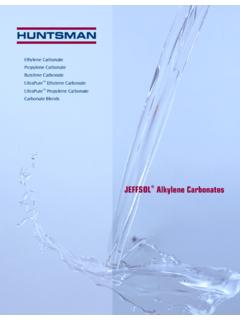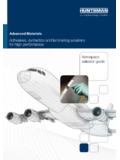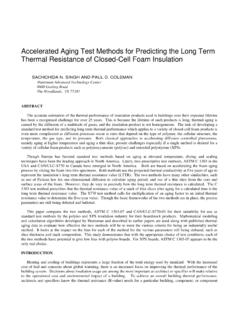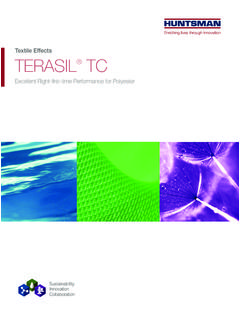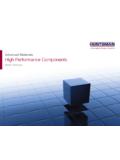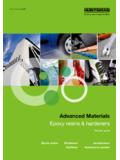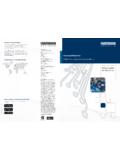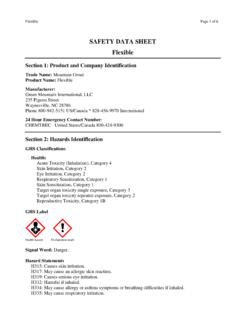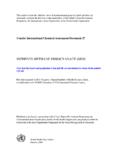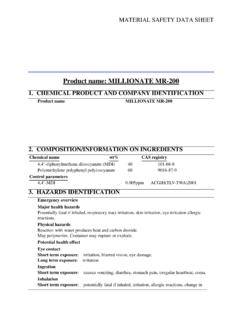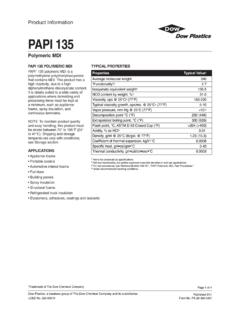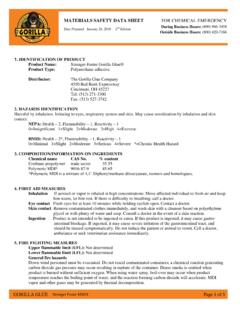Transcription of Paper New advances in polymeric MDI variants-stand
1 EUROCOAT 2002, Barcelona, Spain June 2002 New advances in polymeric MDI VariantsThorsten GurkeApplication and Product Development Manager - AdhesivesHuntsman PolyurethanesEverslaan 45B3078 Everberg, BelgiumTel. +32 2 758 MDI and its variants are commonly used in coating and adhesive component systems are formed by reacting polyols and a polymeric MDI variant . Veryoften the compatibility between the raw materials is limited and results in hazy products,which tend to phase separate, therefore limiting the shelf life of the products. polymeric MDIvariants are also used as crosslinkers in two component systems.
2 Here, the reactivity betweenthe two raw materials is highly important to ensure polymeric MDI variants with high miscibility and their effect within one and twocomponent systems will be discussed. The study focuses on compatibility, reactivitydifferences and long term stability of model prepolymers and two component INTRODUCTIONP olymeric MDI and its variants are important raw materials for coatings and adhesives. It hasbeen recognised for over 40 years and is considered as a commodity product. Often it is believedthat the performance of polymeric MDI cannot be changed or altered. The aim of this Paper is todemonstrate the versatility of polymeric MDI in combination with other main MDI streams,making them the products of choice for one and two component understand the complexity of polymeric MDI it is necessary to review its 2002, Barcelona, Spain June 20021- CHEMISTRYThe production of diphenylmethane diisocyanate (MDI) and its homologue is a complex is produced from a reaction between aniline and formaldehyde, using hydrochloric acid as acatalyst.
3 This reaction produces a complex mixture of polyamines which are phosgenated toobtain a polyisocyanate mixture. Afterwards, this mixture is split into polymeric MDI and MDI consists mainly of two isomers: 2,4'-MDI and 4,4'-MDI. (figure 1)2,4'- MDI 4,4'- MDIF igure 1: MDI isomersThe main effect of the isocyanate groups (NCO) in the 2 and 4 positions is on reactivity. Theisocyanate group in 2 (ortho) - position is three times less reactive than the isocyanate group in 4(para) - position. Pure 4,4' - MDI is solid at room temperature, melts at 38 C and is a major rawmaterial for adhesive and coating applications where high reactivity and linearity is required.
4 The2,4' - MDI isomer is not readily available in 100 per cent purity. Concentrations of up to 50 percent are commercially available. The so-called mixed isomer 50 (MI 50), with a melting point of18 C, exhibits a good compromise between lower reactivity and their melting point, both isomers and their mixtures have very low viscosities, typicallybelow 10 common modification of MDI, especially pure MDI, is the condensation reaction of theisocyanate groups, forming carbodiimide and reversible uretonimine (Figure 2). Uretoniminemodified MDI typically is a liquid at room temperature with a viscosity at 25 C of approximately50 and a functionality of Materials of that kind crystallise at temperatures of about15 2: Uretonimine structurePolymeric MDI is a complex mixture of pure MDI and higher homologue (figure 3).
5 The letter nranges from 1 to higher numbers, meaning that in polymeric MDI, polyisocyanates withfunctionalities of 3 and higher are ,4 -IsomerCH2 NCOOCN4,4 -IsomerR -N-C=N-R O=C-N- REUROCOAT 2002, Barcelona, Spain June 2002 Figure 3: polymeric MDI structureA typical polymeric MDI consists of approximately 50 per cent pure MDI, 30 per cent tri-isocyanate, 10 per cent tetra-isocyanate, 5 per cent penta-isocyanate and 5 per cent higherhomologue. The average functionality of a standard polymeric MDI is about with a typicalviscosity of approximately 200 at 25 C. Standard polymeric MDI is storage stable as nocrystallisation takes place down to temperatures of 0 four product streams described above are often mixed together to produce customisedpolymeric MDI TWO COMPONENT SYSTEMSIn general, two component systems consist of polyol or polyol mixtures and an isocyanatecrosslinker.
6 The two components are mixed together at the application site in various ratios and,after mixing, applied onto the substrate to be bound or coated. Two component systems have theadvantage of fast reaction time, or cure speed, in comparison to typical one component systems,which will be discussed later in the Paper . The main curing mechanism of two componentsystems is the formation of urethane linkages, resulting from the reaction of the isocyanate withthe hydroxyl function of the component systems are commonly used in applications for the building industry, forexample in floor coating, panel laminating adhesives and sealant applications.
7 The individualcomponents are quite often stored in unconditioned warehouses or even on the construction both components need to be storage stable, yielding no change in morphology, for aprolonged time. Typical polyols, like polyethers, are resistant to cold temperatures, until and evenbelow the freezing point. Isocyanates very often tend to crystallise during cold storage. To melt acrystallised isocyanate, temperatures of approximately 80 C are required. Since such heating isvery often not present on the construction site, it is necessary to develop isocyanates which canbe stored under cold conditions.
8 In this study all isocyanates were stored at 5 C for 28 days todetermine the resistance against nEUROCOAT 2002, Barcelona, Spain June 2002 Another important parameter for two component systems is the cure behaviour. The ideal systemshould present long enough working times and then cure almost instantaneously. However asystem of that kind does not exist and compromises have to be made. In this study the cureprofile of the two component systems was determined by monitoring their viscosity increase overtime. The polyol used in all trials was castor Experimental principle:Figure 4 shows the cure profile of SUPRASEC 5025, a standard polymeric the graph shown in figure 4, the following main values can be determined.
9 - The time when the reaction mixture reaches 10 corresponds to the working time, thetime at which the application of the reaction mixture is easy- The time when the reaction mixture reaches 100 corresponds to the open time, themaximum viscosity at which a coating exhibits flow and self levelling properties, whereas inadhesives, the mixture looses its ability to bond different substrates- The time when the reaction mixture reaches 1000 corresponds to the set time, which isespecially of interest for adhesives. It is typically the time at which the adhesive hassufficient strength to allow handling of the the cross over point between the elastic modulus (G') and the loss modulus (G'') wasdetermined.
10 Theoretically this point is the change over from viscous to elastic behaviour,meaning that the material is no longer able to flow. This value represents the minimum time afterwhich the coating or adhesive presents resistance against 4: Cure profile of SUPRASEC 5025, a standard polymeric MDI?100 Time (minutes)10 0001000100 000G , elastic modulusG , G G , loss modulus?, 2002, Barcelona, Spain June 2002 For practical reasons the cure was monitored at 40 C. The ability to repeat the achieved results isvery high with an approximate failure rate of 2 per cent. Naturally, at lower temperatures the curetime is prolonged, whereas at higher temperatures the reaction will be values determined for SUPRASEC 5025 alone are:10 time100 time1000 timeCross Over point38 minutes85 minutes120 minutes145 minutesSeveral mixtures were produced based on the polymeric MDI SUPRASEC 5025, and variedamounts of 4,4 -, 2,4 -MDI, as well as uretonimines.
